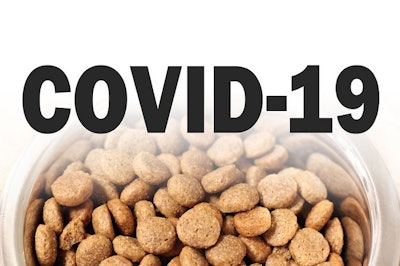
Dog, cat and other pet food companies still have access to co-products from the meat industry, despite region effects from COVID-19 infections, said David Meeker, Ph.D., senior vice president of scientific services for the North American Renderers Association.
“I don’t see any reason why all contracts for rendered ingredients won’t be honored,” Meeker said.
COVID-19 pandemic effects on pet food ingredient production
Meeker fielded many questions over the past week about closures of meat cutting plants due to COVID-19 infections among the workforce. Shuttering these facilities for sanitation and to ensure worker health resulted in some localized disruptions. However, overall meat production to date in 2020 remains above 2019 levels.
"According to U.S. Department of Agriculture data, beef slaughter was down by 21.8% the week ending April 18 compared to that week a year ago, and pork slaughter was down 6.9% from that week in 2019, but poultry meat production was up slightly that week and up year-to-date compared to 2019," he said. "USDA projects total meat production in 2020 to be slightly higher than 2019, but recent food chain disruptions could bring the total down some. If the closed plants can reopen soon as planned, the 2020 supply should be near normal.”
Where there is meat production, there are co-products to be rendered. As meat cutting lines shifted to preparing meat for retail sale rather than food service, there may have been small changes to the cuts of meat, he said. For example, more fat may remain on the meat sold to in supermarkets. While this may slightly alter the stream of materials available for renderers, Meeker doesn’t see this causing any problems. To the contrary, he’s heard that pork bellies, meant for bacon, and chicken wings may end up in the co-product stream without demand from restaurants.
“We’re gaining some and we’re losing some,” he said. Any scarcity remains small-scale. In Minnesota and Iowa, for example, Meeker heard about localized shortages for renderers after major meat cutting plant closures, though.
On the other hand, pet food industry demand for rendered products has grown dramatically, in some cases by 30%, since the onset of the pandemic, he said.
“That kind of increase is going to cause some spot shortages, and maybe some increased prices and maybe inability to fill all those orders, but I expect normal amounts to be produced without a lot of problems, unless things get a lot worse.”
Biosecurity in pet food ingredient supply chain
COVID-19 infections among meat cutting facility employees may be higher than thought, reported USA Today. Along with potentially widespread current infections, more than 150 meat processing plants operate in U.S. counties with COVID-19 infection rates higher than 75% of other counties.
When COVID-19 does strike a community, workers in a rendering facility may be less likely to contract or spread the disease than in other plants. Rendering facilities require fewer people to operate than meat cutting plants, Meeker said. The personnel also works in sparsely staffed, physically separated areas, whereas meat production lines can be crowded. What’s more, in both rendering and meat cutting plants, biosecurity measures already exist to reduce the spread of pathogens, like Salmonella, from people to products. While these measure help with COVID-19 pandemic preparations,
“It’s a new thing to be worried about person to person rather than contaminating the product.”
Sanitary procedures need to be learned and equipment to be installed, but ultimately Meeker doesn’t see any serious disruption to rendered co-product production for pet food ingredients.
















